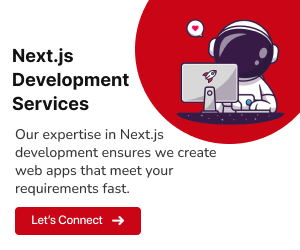Welcome to the dynamic world of web development, where innovation and adaptation are the keys to success. In the United States, the tech landscape is constantly evolving, and staying ahead of the curve is crucial for developers. One such advancement that has been making waves in the USA’s web development scene is Next.js, a React framework known for its simplicity and robust features. If you’re considering embarking on a journey into Next.js app development in the USA, this comprehensive guide will provide you with valuable tips and insights into the latest trends.
Unveiling the Essence of Next.js
To unlock the full potential of Next.js in the realm of web development, it’s essential to grasp the essence of this framework and why it stands out in the USA’s tech landscape. Next.js isn’t just another JavaScript framework; it’s a powerful toolkit designed to empower developers in creating dynamic, high-performance web applications. At its core, Next.js builds upon the foundation of React, a JavaScript library developed by Facebook. This seamless integration with React means that if you’re already familiar with React, you’re on the right track. Next.js takes React’s capabilities to the next level, adding powerful features and optimizations, making it a compelling choice for developers.
One of Next.js’s standout features is its innate support for Server-Side Rendering (SSR). SSR is a technique that goes beyond client-side rendering by rendering web pages on the server. This approach has far-reaching implications for website performance, SEO (Search Engine Optimization), and user experience. By harnessing SSR, Next.js applications can deliver blazing-fast initial page loads, an essential factor in retaining users and improving search engine rankings. Additionally, Next.js offers Static Site Generation (SSG), a boon for content-heavy websites, blogs, and e-commerce platforms, where speed is paramount. Pre-building web pages at build time results in highly optimized, static HTML files that can be deployed to content delivery networks (CDNs), ensuring rapid page loads and minimal server load. In essence, Next.js equips developers with the tools needed to create modern web applications that are not only visually engaging but also highly efficient and performant.
Essential tips for Next.js development in the USA

When it comes to web development in the USA, staying at the forefront of technology is key to success. One technology stack that has been gaining traction rapidly is Next.js. Known for its robust features and versatility, Next.js has become a go-to framework for developers looking to create dynamic and performant web applications. In this guide, we’ll explore a set of essential strategies for Next.js development in the USA. These strategies will help you harness the power of Next.js to build cutting-edge web applications that meet the ever-evolving demands of the American tech landscape.
1. Master React Basics First
Before delving into the world of Next.js, it’s paramount to build a strong foundation in React. React is the bedrock upon which Next.js is constructed, and a deep understanding of React components, state management, and props is invaluable. Take the time to explore the React ecosystem thoroughly. Familiarize yourself with functional components, class components, hooks, and context API. Understanding these core concepts will empower you to leverage Next.js effectively and efficiently.
2. Embrace Server-Side Rendering (SSR)
Server-Side Rendering (SSR) is Next.js’s superpower. By embracing SSR, you open the door to a multitude of benefits. It not only enhances website performance by pre-rendering pages on the server but also plays a pivotal role in Search Engine Optimization (SEO). Google and other search engines favor SSR because it ensures that your content is readily accessible to web crawlers. As SEO is a critical factor in driving organic traffic, mastering SSR is a must for Next.js developers in the USA.
3. Leverage Static Site Generation (SSG)
Static Site Generation (SSG) is another arrow in Next.js’s quiver that you should consider when building websites, especially content-heavy ones or e-commerce platforms. SSG involves pre-building pages at build time, resulting in lightning-fast load times and reduced server load. This approach not only enhances user experience but also contributes to cost savings by reducing the need for complex server infrastructure.
4. Optimize for Mobile-First Development
With the ubiquity of mobile devices, mobile-first development is no longer an option; it’s a necessity. Ensure that your Next.js applications are not just responsive but are designed with mobile users as a primary focus. Test rigorously on various devices and screen sizes to guarantee a seamless experience for all users. Prioritizing mobile optimization aligns with the latest trends and ensures your web applications reach a broader audience in the USA.
5. Use TypeScript for Strong Typing
TypeScript is making waves in the world of Next.js development, and for a good reason. It offers robust static typing, which can catch errors during development and improve code quality and maintainability. When working on Next.js projects in the USA, consider adopting TypeScript to harness the full power of strong typing and enhance the reliability of your codebase.
6. Embrace the JAMstack Architecture
The JAMstack architecture (JavaScript, APIs, and Markup) is a rising star in the web development arena. It perfectly aligns with Next.js’s capabilities, offering speed, security, and scalability. By embracing JAMstack, you can decouple the front end from the back end, making your applications easier to maintain and scale. It’s an architectural trend that’s gaining momentum and is well worth exploring in your Next.js projects.
7. Integrate with Headless CMS
Efficient content management is a top priority for many web developers. Integrating Next.js with a headless Content Management System (CMS) like Contentful or Strapi can be a game-changer. It streamlines content creation, editing, and distribution, empowering you to deliver dynamic and up-to-date web experiences without the hassle of managing content manually. This trend aligns with the need for streamlined content workflows, a common demand in the USA’s web development landscape.
8. Explore Serverless Functions
Serverless computing is a paradigm shift that’s taking the USA by storm. Next.js plays well in this space, allowing you to leverage serverless functions through platforms like AWS Lambda and Vercel. These functions can handle tasks such as form submissions, data processing, and API calls efficiently, all without the overhead of managing server infrastructure. This trend can save time and resources while improving the scalability and responsiveness of your Next.js applications.
9. Focus on SEO Optimization
Search Engine Optimization (SEO) remains a cornerstone of web development, and Next.js offers valuable tools to bolster your SEO efforts. Leveraging SSR and SSG capabilities, you can ensure that your content is not only easily discoverable but also ranks higher in search engine results. This is particularly critical in the highly competitive online landscape of the USA, where businesses strive to capture the attention of a vast online audience.
10. Stay Updated with Next.js Releases
The world of web development is constantly evolving, and Next.js is no exception. It’s vital to keep a watchful eye on Next.js updates. Each release brings new features, bug fixes, and performance enhancements that can give your projects an edge. Staying current with the latest Next.js developments is a hallmark of a successful developer in the USA, as it allows you to harness the full potential of this versatile framework. Regularly checking for updates and understanding how they impact your projects can set you apart in the competitive tech landscape.
Related : Tips for Landing a next.js app developer Job in the USA
Emerging Trends in Next.js Development in the USA

In the rapidly evolving realm of web development, staying ahead of the curve is essential. In the United States, a hotbed of technological innovation, developers are continually seeking the latest trends and tools to enhance their skills and deliver cutting-edge web applications. When it comes to Next.js development in the USA, it’s vital to be aware of the emerging trends that can give your projects an extra edge. In this article, we’ll explore some of the most exciting and relevant trends in Next.js development that are shaping the landscape in the USA.
1. Serverless Computing
Serverless computing is experiencing a rapid rise in popularity within the USA’s tech landscape. This architecture offers a paradigm shift in how applications are developed and deployed. What’s particularly exciting is that Next.js seamlessly integrates with serverless functions. These functions, such as those offered by AWS Lambda and Vercel, allow developers to focus on writing code rather than managing servers. This trend is not just about efficiency; it’s also cost-effective, as you only pay for the resources you consume. By embracing serverless computing in your Next.js projects, you’re positioning yourself at the forefront of a transformative movement in the web development space.
2. Mobile-First Design
In an era dominated by mobile devices, adopting a mobile-first design approach is paramount. This trend emphasizes creating web applications with mobile users as the primary audience. Responsive design is no longer optional; it’s a fundamental requirement. Next.js developers in the USA are recognizing the importance of ensuring that their applications look and function flawlessly on various mobile devices and screen sizes. Prioritizing mobile-first design isn’t just a trend; it’s a user-centric approach that guarantees inclusivity and a broader reach for your Next.js applications.
3. E-commerce Integration
The e-commerce sector is booming, and Next.js is emerging as a preferred choice for building e-commerce platforms. The combination of speed and versatility makes Next.js a prominent trend in web development for online businesses. Leveraging Next.js for e-commerce integration allows you to create high-performance, scalable, and feature-rich online stores. As the e-commerce landscape continues to evolve, Next.js remains a powerful tool in the USA’s web development arsenal.
4. API-driven Development
API-driven development has become a cornerstone of modern web applications, and when coupled with Next.js, it becomes a dynamic duo. APIs allow seamless data integration and enable real-time content updates, enhancing the user experience. This trend aligns perfectly with the demand for data-driven and interactive web applications in the USA, making Next.js a compelling choice for developers seeking to create engaging and data-rich platforms.
5. Progressive Web Apps (PWAs)
Progressive Web Apps (PWAs) are revolutionizing the way users interact with websites. These applications offer app-like experiences on the web, including offline capabilities, push notifications, and improved performance. Next.js provides developers with the tools and capabilities to create PWAs effortlessly. In a mobile-driven world, PWAs are becoming increasingly popular, and their integration with Next.js aligns perfectly with the demand for more immersive and interactive web experiences.
6. Headless Commerce
The concept of headless commerce perfectly aligns with Next.js’s architecture. It involves decoupling the front end and back end of e-commerce platforms, allowing for flexibility and scalability. This trend is particularly relevant for businesses seeking to adapt quickly to changing market dynamics and customer demands. Next.js’s capability to handle headless commerce makes it a standout choice for developers looking to create modern, agile, and future-proof e-commerce solutions.
7. Increased Focus on Security
Security remains a paramount concern in web development. Next.js developers in the USA are placing an increased emphasis on implementing robust security measures. This includes practices such as input validation, secure authentication and authorization, and protecting against common web vulnerabilities. As the digital landscape becomes more complex and threats more sophisticated, prioritizing security is not just a trend; it’s a fundamental responsibility to safeguard applications and user data.
8. Performance Optimization
Exceptional performance is a hallmark of successful web applications. Next.js developers understand the importance of continuous monitoring and optimization. Tools like Lighthouse and Google PageSpeed Insights are used to fine-tune applications for speed, responsiveness, and overall user experience. By focusing on performance optimization, Next.js developers in the USA are ensuring that their applications deliver outstanding results in an increasingly competitive online environment.
9. Real-time Features
User engagement and interactivity are critical factors in today’s web applications. Integrating real-time features into Next.js applications is a growing trend. This includes live chat, notifications, and collaborative features that enhance user engagement and satisfaction. Real-time functionality can set your Next.js projects apart by providing users with dynamic and interactive experiences, further solidifying your presence in the ever-evolving digital landscape.
10. Documentation
Comprehensive documentation is the unsung hero of successful Next.js projects. It’s not just a trend; it’s a necessity for efficient collaboration and long-term codebase maintenance. Well-documented code and project resources enable developers to work seamlessly, understand complex systems, and troubleshoot effectively. In the USA’s competitive tech scene, clear and accessible documentation is a hallmark of professionalism and excellence in Next.js development.
Also Read: How to Become a next.js Developer in the USA
Conclusion
In conclusion, Next.js app development in the USA presents an exciting journey filled with opportunities to create fast, dynamic, and scalable web applications. By following these tips and staying attuned to the latest trends such as server-side rendering (SSR), mobile-first development, and embracing the JAMstack architecture, you can stay at the forefront of web development.
Additionally, maintaining a strong focus on SEO optimization, robust testing, and vigilant security measures will help ensure the success and sustainability of your Next.js projects. With these strategies in place, you’ll be well-prepared to excel in the ever-evolving landscape of web development in the USA and deliver exceptional digital experiences to users. Happy coding, and may your Next.js ventures be both rewarding and transformative.


























